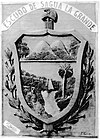Sagua la Grande, Cuba
| Sagua la Grande | ||
|---|---|---|
| Municipality | ||
|
||
| Nickname(s): La Villa del Undoso | ||
 Sagua la Grande municipality (red) within Villa Clara Province (yellow) and Cuba |
||
| Location of Sagua la Grande | ||
| Coordinates: 22°48′31″N 80°04′16″W / 22.80861°N 80.07111°WCoordinates: 22°48′31″N 80°04′16″W / 22.80861°N 80.07111°W | ||
| Country |
|
|
| Province | Villa Clara | |
| Founded | 1812 | |
| Established | 1842 (Municipality) | |
| Area | ||
| • Total | 661 km2 (255 sq mi) | |
| Elevation | 15 m (49 ft) | |
| Population (2004) | ||
| • Total | 56,097 | |
| • Density | 84.9/km2 (220/sq mi) | |
| Time zone | EST (UTC-5) | |
| Area code(s) | +53-422 | |
Sagua la Grande (nicknamed La Villa del Undoso, sometimes shortened in Sagua) is a municipality and city located on the north coast of the province of Villa Clara in central Cuba, on the Sagua la Grande River. The city is close to Mogotes de Jumagua, limestone cliffs. Many cays of the Sabana-Camaguey Archipelago are located off the northern coast.
Sagua la Grande was founded in 1812 and established as a municipality in 1842. By the beginning of the 20th century, the city and its port (Isabela de Sagua), were an important commercial center. Presently, its economy is based on the sugar, chemical, mechanical, and food industries. Cattle raising and fishing are other important economic activities.
Two city historians are notable. Antonio Miguel Alcover Beltrán left to the inheritance of the events related to the 19th century thanks to his personal interrogations to each one of the authors of history; and at the moment Pedro Suárez Rojo (Tintín) has been in charge to rescue all 20th century and leaves from the 21st century in his famous “Tintin Collection” that includes newspapers, books, photos, films and videos of all the historical events of the referred time.
In 2004, the municipality of Sagua la Grande had a population of 56,097. With a total area of 661 km2 (255 sq mi), it has a population density of 84.9/km2 (220/sq mi).
The municipality is divided into the barrios of Baire, Calabazar de Sagua, Chinchila, Este, General Nodarse, Isabela de Sagua, Jumagua, Malpáez, Oeste and Sitiecito.
The city's wide streets and little traffic give it a calm atmosphere.
In recent decades there has been a lack of new construction. Consequently, the older buildings, left over from colonial times, are in a state of decay. One of the most beautiful buildings in this city, El Casino Español (The Spanish Casino) built in 1908, was the meeting place for the Sociedad Sagüera (Social Club of Sagua). The historical center of the city retains the neoclassic essence of its constructions and the layout of its streets. The historical center of Sagua La Grande was declared National Monument on December 6th, 2011, due to its architectural values and its preservation state.
...
Wikipedia



